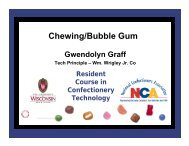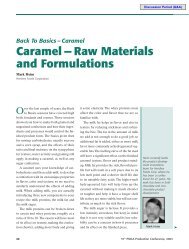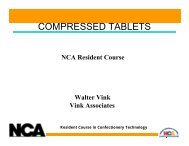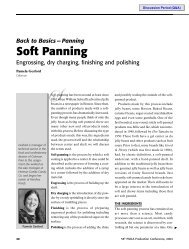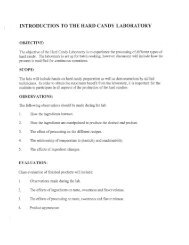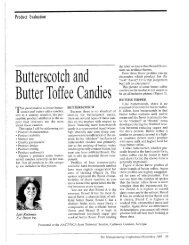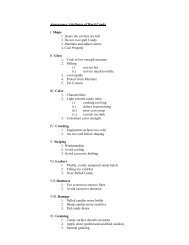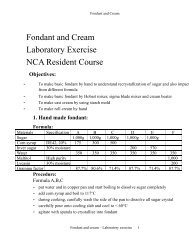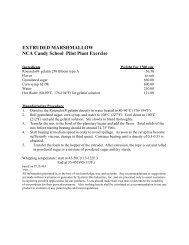2001 Grained and Ungrained Confections - staging.files.cms.plus.com
2001 Grained and Ungrained Confections - staging.files.cms.plus.com
2001 Grained and Ungrained Confections - staging.files.cms.plus.com
Create successful ePaper yourself
Turn your PDF publications into a flip-book with our unique Google optimized e-Paper software.
<strong>Grained</strong> <strong>and</strong> <strong>Ungrained</strong> <strong>Confections</strong><br />
Fondant can be<br />
made on a relatively<br />
small scale by batch<br />
methods using<br />
cooking kettles <strong>and</strong><br />
cooled batch mixers.<br />
dants intended for very smooth cremes have<br />
sugar crystals below 12 microns, but for<br />
some applications where coarser textures<br />
are desired they range up to 40–50 microns.<br />
Whatever texture is required, it is important<br />
to get a consistent particle size distribution<br />
because it affects the viscosity of<br />
the fondant when it is used for starch <strong>and</strong><br />
starchless moulding, particularly singleshot<br />
depositing, where viscosity control is<br />
critical. Sugar particle size also affects the<br />
setting rate of the deposited fondant or<br />
cremes in which it is used. This is particularly<br />
important in starchless moulded products<br />
where setting times, ready for<br />
demoulding, are 10–15 minutes, instead of<br />
the hours available in starch moulding.<br />
Controlling particle size distribution<br />
requires the following:<br />
• Accurate recipe control.<br />
• Accurate water content control.<br />
• Accurate control of crystallization temperature.<br />
• Consistent mixing speed/shear rate.<br />
To illustrate this, we are going to discuss<br />
fondant-making both by h<strong>and</strong> <strong>and</strong> by<br />
machine using three recipes, to illustrate<br />
the effect of recipe on crystallization rate<br />
<strong>and</strong> the effect of recipe on water activity.<br />
We will also show the effect of mixing rate<br />
on particle size distribution.<br />
Commercial Equipment<br />
Fondant can be made on a relatively small<br />
scale by batch methods using cooking kettles<br />
<strong>and</strong> cooled batch mixers to crystallize<br />
the syrup. The old ball beaters are still in<br />
operation doing this.<br />
On a larger scale continuous methods<br />
are used, consisting basically of four parts:<br />
• A recipe batching system to put<br />
together an uncooked 75 percent soluble<br />
solids syrup.<br />
• A cooker to boil the syrup to the correct<br />
moisture content.<br />
• A cooling drum or other means of cool-<br />
ing the syrup as a thin unagitated film to<br />
a controlled uniform temperature.<br />
• A water-cooled mixer to vigorously mix<br />
the cooled syrup to crystallize it <strong>and</strong><br />
remove the heat of crystallization given<br />
out as the sugar crystals are formed.<br />
There are many types of equipment for<br />
doing this.<br />
Accurate control of each stage for consistent<br />
product <strong>and</strong> efficient operation of<br />
this <strong>and</strong> subsequent processes is essential.<br />
Uses of Fondant<br />
Fondant is used in several ways:<br />
• For making starch or starchless moulded<br />
units, often flavored with peppermint or<br />
fruit flavors <strong>and</strong> sugar crusted to give a<br />
glistening appearance.<br />
• For making cremes, which are generally<br />
softer than fondants <strong>and</strong> used as centers<br />
for chocolate enrobing, or as fillings for<br />
shell-moulded or single-shot moulded<br />
products.<br />
• To control the crystallization of other<br />
confections, such as fudge or nougat, by<br />
adding it to seed their graining.<br />
Moulded Fondants<br />
Moulded fondants vary in texture from<br />
crisp, hard ones used for coating in sugar<br />
crystals to softer ones coated in chocolate.<br />
The final soft texture is made by adding<br />
the enzyme invertase to the recipe.<br />
Moulded fondants are made by reheating<br />
the base fondant to the required<br />
depositing temperature, generally 160°–<br />
170°F, <strong>and</strong> adding a thinning syrup to adjust<br />
its viscosity. A typical recipe is shown in<br />
Figure 10.<br />
The thinning syrup is similar in recipe<br />
to the fondant but has a higher moisture<br />
content, <strong>and</strong> often a humectant such as sorbitol<br />
added to it. The temperature of the<br />
mix is finally adjusted to the depositing<br />
temperature. Color is mixed in before the<br />
fondant is deposited into starch or starchless<br />
moulds. Starch-moulded fondants are<br />
left for 6–8 hours in a conditioned room ➤<br />
48 55 th PMCA Production Conference, <strong>2001</strong>



